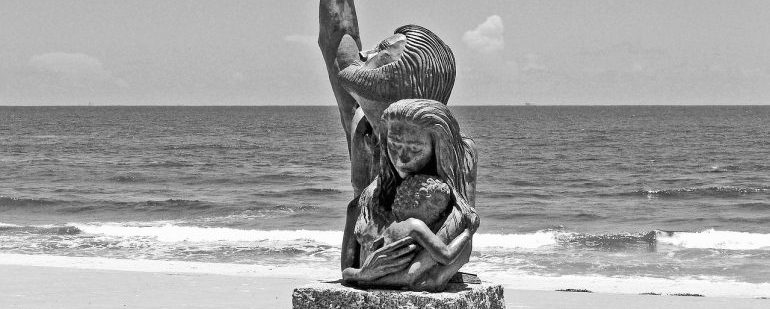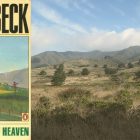Crafting A Novelscape

In the words of my own personal goddess of literature, Joyce Carol Oates, one should “…never underestimate the power—benevolent, malevolent, profound and irresistible— of place.” These words make my heart keen. In fact, I recently gave a lecture on what I consider both the fundamentally most important and most overlooked character in a long work of fiction: the novelscape. Yes, believable characters within this novelscape are critical too. But in order to gain the highest level of believability, setting, the whole combination of light and depth and detail that makes up the writer’s imaginary world, the landscape needs to be treated like a character, too.
I define “novelscape” as a series of setting specific details that radiate authenticity and personify space. Elbow deep in the work of revising my novel manuscript, I had a fresh breakthrough moment after reading Margaret Atwood’s 2003 novel, Oryx and Crake. I’ll admit the cover of my First Anchor Books Edition seemed less than promising: Two mascara-coated sets of eyelashes frame very green human eyes, set behind a montage of leaves and a dark purple gerbera daisy. But after months of it flitting from shelf to shelf as I struggled to find more space in my tiny home, I finally read the book.
Oryx and Crake is a novelscape in all its glory. Here is a world that echoes Atwood’s earlier novel, A Handmaid’s Tale: it’s a futuristic look at the condition of being human in a world that has advanced to such a degree of automation, genetic modification, and lack of emotion that homo sapiens is in peril. Jimmy, aka Snowman, the protagonist, is a rare unmodified human, living in a tree, his biggest worries the most basic: food and water. But he is lonesome in a world inhabited solely by genetically engineered pseudo humans named after his former best friend, Crake. Who consequently gets the girl Jimmy is in love with, Oryx, to a devastating end. While this is a conventional relationship dynamic, I’d never seen it played out in such a world where strange diseases and creatures like Rakunks (raccoon and skunk cross) roam the wreckage of what used to be a pristine world. Through Jimmy’s eyes, “The buildings that didn’t burn or explode are still standing, though the botany is thrusting itself through every crack. Given time it will fissure the asphalt, topple the walls, push aside the roofs…Soon this district will be a thick tangle of vegetation…It won’t be long before all traces of human habitation will be gone.”
Strangely, in a landscape where sprayguns, which appear to use radiation to reduce their targets into pink puddles, and the BlyssPluss bill that renders both an amazing sexual experience and permanent sterility, readers can identify with Jimmy’s world through the inclusion of elements of our very real Earth: we can imagine vines tangling over busted structures, envision the aftermath of a war zone. We can sense Jimmy’s panic as he realizes that the world he was born into is being erased, threatening to erase his relevance within it.
Atwood is a master at convincing her reader that her novelscape is legitimate, even though it’s not even based on a real physical space. Yet in the above example, and in countless other places—solarcars are abandoned with motorcycles, an assisted suicide website is mentioned amongst a conversation on online porn—when Atwood pairs an element of our current realities with an imagined one, we buy it. We might not be able to comprehend every element of Jimmy’s world, but his escape from a bunch of hungry pigoons, a bad injury to his very human, non-Noo-skin (and therefore not self-healing) foot, and his desire to drink away his pain when he finds a stash of beer echo behaviors and themes from human history. “If only he could find a cave, a nice cave with a high ceiling and good ventilation and maybe some running water, he’d be better off.” Jimmy yearns for something pre-human in advanced human vocabulary and concerns, in details like “ceiling height” and “ventilation.” In a landscape full of carbon-copy green eyed-Crakers who have estrus cycles, there are references to Shakespeare, to-do lists, a litter box, a peanut butter and jelly sandwich. These authentic details make digesting the premise of an imagined world possible, though not always comfortable. The novel ends with the possibility of Jimmy encountering other humans, which would not be so compelling had this encounter not been prefaced by three hundred and sixty pages that emphasize his aloneness. In this weird, semi-sterile world of Crakers and destruction, we want Jimmy to find his kind. The kind that emotes, that has skin that sweats and bruises, the kind who have sex to express their love, not to procreate.
Oryx and Crake teems with well-crafted, full-realized characters who demand a landscape as complex as they are. Without a highly inventive but completely legitimized space to interact with each other and themselves, they wouldn’t be compelling characters. As Atwood crafts them to reflect their novelscape, she seduces the reader into accepting the parameters of a space where we cannot actually go.



